It’s Funny, how a person often described as a “Careless Lab technician” led to the accidental discovery that changed the course of modern medicine. His name was Alexander Fleming.
On one fine day, Fleming returned to his lab after a week-long vacation just to find out, his staphylococcal culture plate (Bacterial culture) was accidentally contaminated by “white fluffy mass” (as he described it) which was a secreting something that averted the growth of staphylococcal colonies. He'd accidentally discovered the first antibiotic and named it "Penicillin".
 Image by pixabay under free to use license
Image by pixabay under free to use licenseWe know that Antibiotics have saved more lives than any other discovery, and they've been a part of the utmost of medical treatment since the 1940s with one estimate being that about half of the people who have lived in the past 50 years have taken them at least once. Before it was discovered, people called them "bad organisms".
We need to understand, bacteria also keep on mutating in response to threats. and we have been using these drugs for more than 80 years now. This Mutating ability of bacteria started a great war with modern-day antibiotics which most of us are unaware of.
Let's Start with Bacterial Structure.
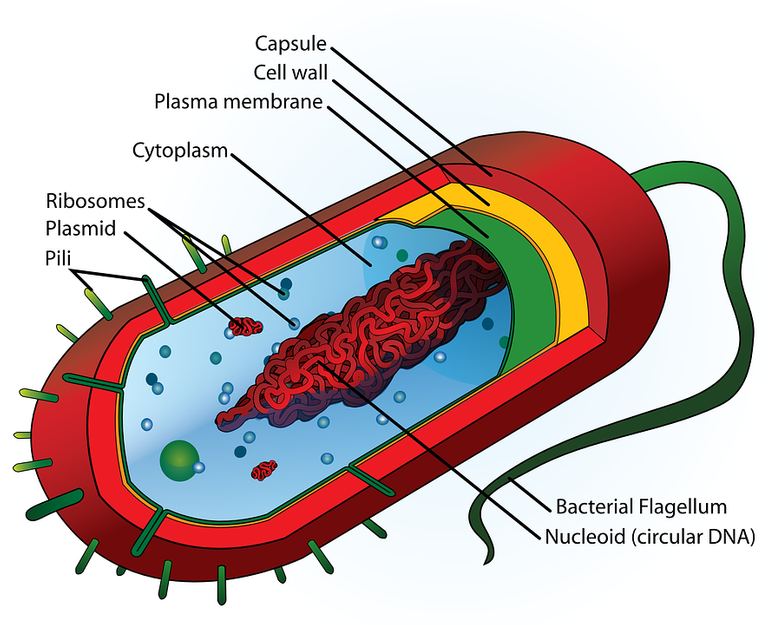 Bacterial Structure. Image by Pixabay under Free to Use license
Bacterial Structure. Image by Pixabay under Free to Use licenseFrom the Image, you can say, bacteria have a really simple structure. You won't find any nucleus or other membrane-bound cell organelles such as mitochondria, Golgi bodies, Endoplasmic reticulum, etc. Due to this reason, they are classified as Prokaryotes.
The bluish jelly-like fluid that you can see is the cytoplasm. All the cell components are scattered here. Some of those cell components are:
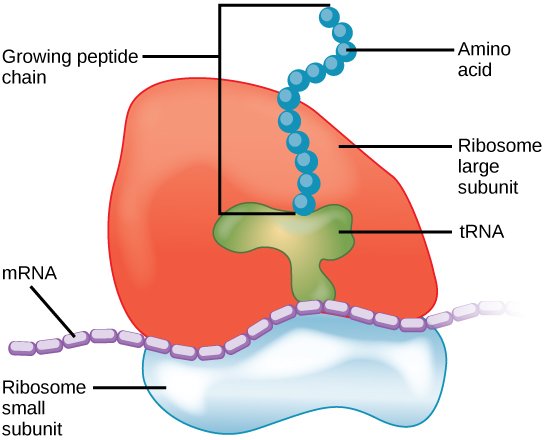 Ribosome structure showing larger subunit 50s and smaller subunit 30s. Image by Wikipedia under CC BY 4.0 license
Ribosome structure showing larger subunit 50s and smaller subunit 30s. Image by Wikipedia under CC BY 4.0 license- Ribosome -Let's make some Proteins - These are the site of Amino acid(Protein) synthesis. These proteins later form the overall structure of the bacteria. Two subunits namely the 30s and 50s make up the ribosome structure. Here in the image, you can see the larger subunit "50s" and the smaller subunit below "30s". A strand of messenger Rna is passing between them encoding amino acids, which further collectively makes protein. These proteins are either structural or functional.
 Double-stranded Circular DNA with Small circular plasmids. Image by Wikipedia under CC BY-SA 2.5 license
Double-stranded Circular DNA with Small circular plasmids. Image by Wikipedia under CC BY-SA 2.5 license - Nucleoid - The Recipe Book: These are the irregular regions that contain bacterial chromosomes. Most of the bacteria contain just 1 chromosome with circular double-stranded DNA. That DNA is just a recipe book for bacterias to cook specific proteins. Keep in mind some bacteria can have more than 1 chromosome.
- Plasmids - I fight Antibiotics: These are small double-stranded DNA, independent of the central DNA. Well, Plasmids are not that essential to the bacteria as they contain very few genes. But these genes can later help encode proteins that might help bacteria fight antibiotics. Also, Bacteria can function normally without plasmids.
Cell Envelope - I Protect bacteria
It is the outer layer of bacteria that compromises the inner plasma membrane and outer cell wall as you can see in the picture above. Sometimes outer capsule helps bacteria to survive in extreme conditions. The Plasma membrane acts as a semi-permeable barrier that decides what comes in and what goes out. The most important structure that gives bacteria its shape and protects it is the cell wall. The cell wall can be thick or thin. This property divides bacterias into two categories. Gram-positive and Gram-Negative bacteria.
Gram-Positive bacteria - I have a Thick Cell wall
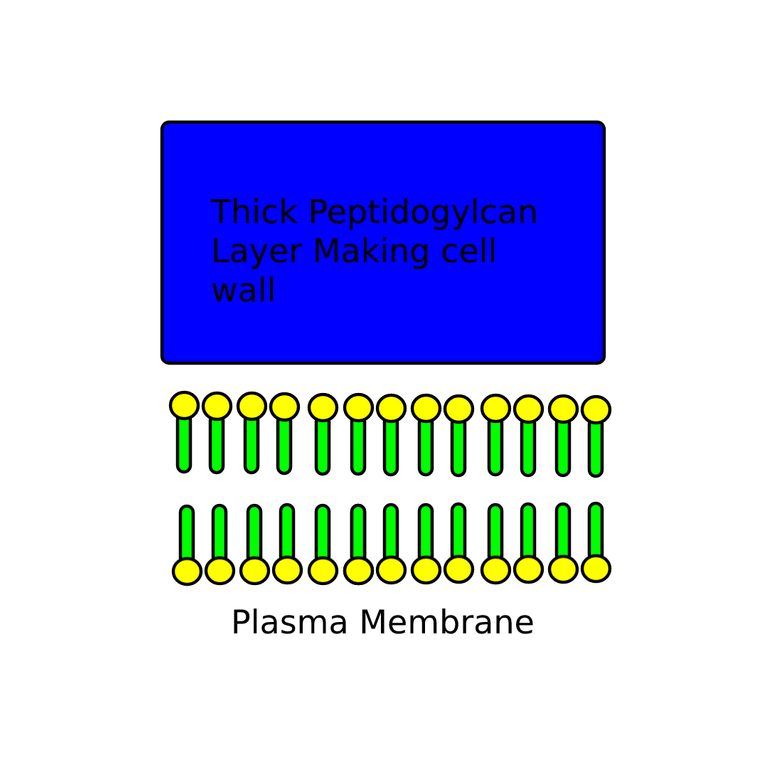 Cell wall of Gram +ve Bacteria showing thick peptidoglycan layer and one layer of plasma membrane. Image Belongs to @idoctor
Cell wall of Gram +ve Bacteria showing thick peptidoglycan layer and one layer of plasma membrane. Image Belongs to @idoctorGram-positive bacteria have a thick cell wall, as you can see from the image, it has one layer of plasma membrane below and a thick layer of peptidoglycan layer above. It's called "Gram-positive" for a reason. In Gram test which is a dye test to separate the bacteria, this one gives a positive result which is it retains the dye due to its thick cell wall and gives purple color. Also, this type has got just one layer of the plasma membrane. Some common Bacteria in this group are staphylococci, streptococci, Corynebacterium diphtheria, Bacillus anthracis
Gram-Negative - I have a thin cell wall
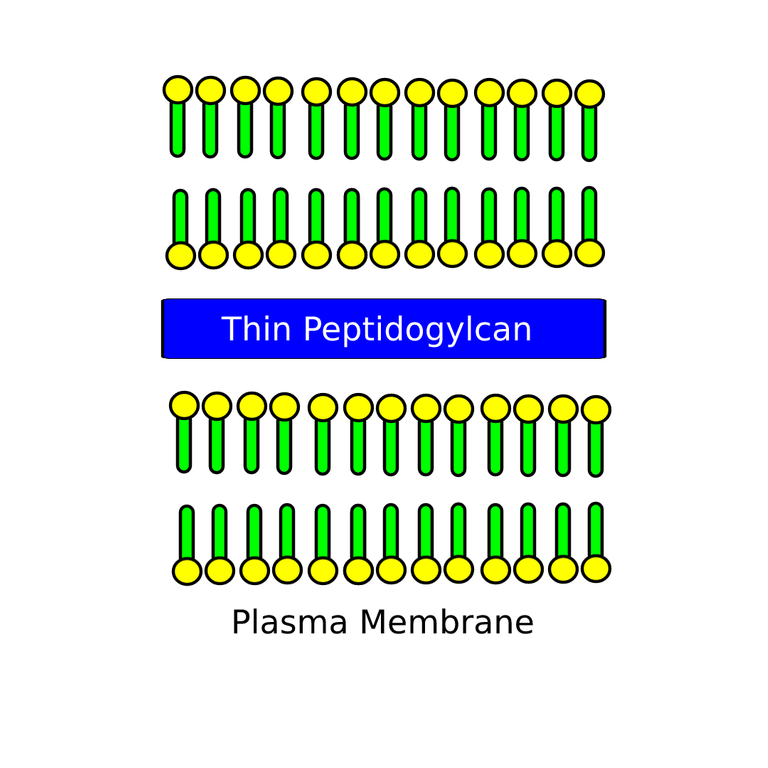 Cell Wall of Gram -Ve bacteria showing thin peptidoglycan layer and two layers of cell membrane. Image belong to @idcotor.
Cell Wall of Gram -Ve bacteria showing thin peptidoglycan layer and two layers of cell membrane. Image belong to @idcotor.Just opposite of gram-positive, these bacteria have a thin layer of peptidoglycan that makes up their cell wall. In addition, the cell wall also contains an outer cell membrane made of phospholipids and lipopolysaccharide.
Due to the thin layer, the cell wall loses its ability to retain the dye during gram staining hence giving it Red color.
Some common bacteria in this group are E.coli, Salmonella, Proteus, Pseudomonas, Kleibsella.
Let's See How Does Antibiotics Kill Bacteria.
Just imagine Antibiotics as Hitmans. Their primary objective is to target bacteria and kill them sparing the human cells. They either act by directly killing the bacteria or slowing down the growth process. This different mechanism of antibiotics classifies them into two categories. Both of them can be equally important. Different situations call for different antibiotics
- Bacteriostatic - Slows down the growth process.
- Bactericidal - kills the bacteria directly.
Bacteriostatic
As I said this class of antibiotics slows down the growth of bacteria and kind of inhibits them to multiply eventually killing them. But how? well there are different types of antibiotics in this category that act differently.
DNA synthesis inhibitors: As the name suggests this class of drugs interferes with bacterial DNA replication. IF the DNA doesn't multiply, bacteria become useless and die. When a bacterial DNA replicates itself, it needs to unwind itself, because of course two strands of DNA are bonded together. When DNA unwinds itself it creates a problem of Supercoiling at the terminal ends of DNA. This problem needs to be solved for successful replication. Bacterial Enzyme Known as Topoisomerase-II comes in as an engineer and solves the twisting problem. See, Topoisomerase is an interesting enzyme. It has two hands. One hand cuts and the other one Ligates. Therefore it cuts down one end of the supercoiled DNA, unwinds it and the other hand ligates it.
This Topoisomerase -II enzyme's second arm which ligates is inhibited by DNA synthesis inhibitors. Therefore, it cuts the DNA but loses the ability to ligate it which turns the DNA into thousands of fragments.RNA synthesis Inhibitors: There is a drug "Rifampicin" which specifically inhibits the RNA polymerase enzyme in bacteria which eventually inhibits the synthesis of RNA. No RNA means No proteins. No protein means useless Bacteria.
Protein Synthesis Inhibitors: This group of bacteriostatic directly inhibits the protein synthesis. Here either we have the 50s subunit inhibitors or 30s subunits inhibitors of the Ribosome. Some antibiotics attach themselves to the 50s subunit of the ribosome and disrupt the protein synthesis directly. Examples: Macrolides ( Erythromycin, Azithromycin, etc), Chloramphenicol.
Then there are drugs that attach themselves to the 30s subunit and change their shape interfering with protein synthesis. Such as Aminoglycosides(Streptomycin, Gentamycin, Neomycin, etc), Tertacyclins(Doxycycline, Minocycline).
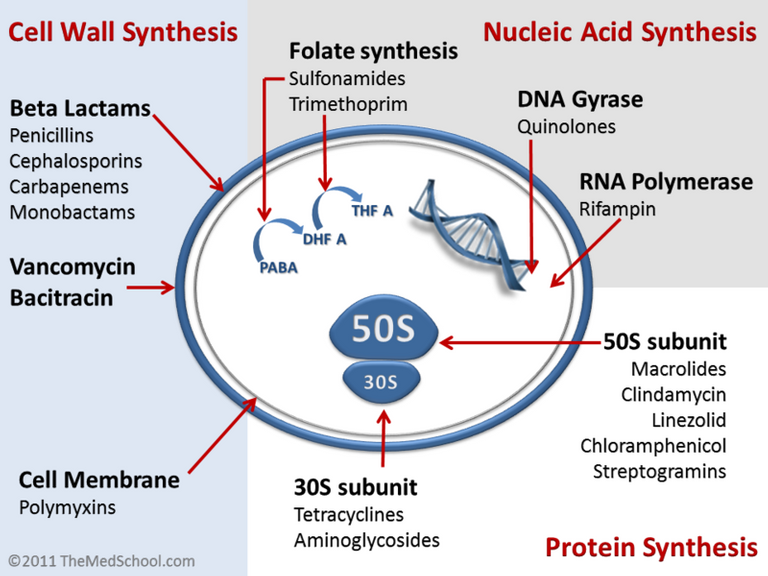 Different Groups of Antibiotics. Image by Wikipedia under CC BY-SA 3.0 license.
Different Groups of Antibiotics. Image by Wikipedia under CC BY-SA 3.0 license.
Bactericidal - Cell wall Synthesis Inhibitors.
This group of drugs directly interrupts the cell wall synthesis and sometimes by injuring the cell membrane too. Some of the drugs in this category are penicillins, cephalosporins, carbapenems, monobactams. Another group is Vancomycin and bacitracin.
In bacteria, the synthesis of cell walls depends on the enzyme called transpeptidase. Penicillins attach with penicillin-binding protein and stop the synthesis of transpeptidase stopping the formation of the cell wall and killing the bacteria.
Bacteria Vs Antibiotics
Let's talk about antibiotic resistance now. How some bacteria fight the antibiotics and acquire resistance. I talked about two groups of bacteria above differentiated according to their Cell wall composition. Gram +ve bacteria have a thick cell wall and gram -ve have a thin cell wall.
When penicillin was discovered, some gram -ve bacteria were already resistant to it. Well, because penicillin acts very effectively on the peptidoglycan layer, Therefore a thick peptidoglycan layer would be a favorable environment for it to act which is found in Gram +ve bacteria. Also, in Gram -ve bacteria there is an extra cell membrane that inhibits the penicillin to act.
This is just one example, there are different ways that a bacteria can shield itself from antibiotic effects.
As I talked about Plasmids briefly. These are separate DNA floating around in the cytoplasm. Plasmids are like the bacteria's hidden weapon. It is activated when needed the most. These plasmids contain the genes that encode proteins which later help for antibiotic resistance.
For Plasmids to work, it needs to attach itself to the central Circular DNA. Then the genes in the plasmids express themselves to make a copy of mRNA. This mRNA works with the Bacterial Ribosomes to encode proteins. Newly formed proteins are what become, a bit new enzymes or different structural proteins that are a bit different in shapes or function than their previous copies. This is what gives the bacteria its resistance.
Some Examples of these proteins are the Beta-Lactamase enzyme which inactivates the Beta-lactam ring of the penicillin causing resistance to it. Also, An Efflux pump can be made by the bacteria in the cell wall which pumps out the antibiotics making it useless. Also, some bacteria can modify their components' shapes, such as, the gene expression from a plasmid can create new proteins which can change the shape of penicillin-binding proteins making the penicillin useless. This is also called MRSA or methicillin-resistant staph aureus.
But, How do Bacteria Get those Resistance genes in the first place?
Well, there are various reasons. But most popular is the Vertical transmission of resistant genes which happened somewhere in the evolution chain. It means the resistant gene was created by the mutation and kept on passing.
Another theory is Horizontal transmission. This can happen in any of these 3 ways.
 Three ways of Horizontal Transmission of genes. 1st showing Transduction by bacteriophage virus. 2nd Transformation by releasing cellular DNA after death. 3rd Bacteria transferring DNA to another Bacteria by conjugation. Image by Wikipedia under CC BY-SA 3.0 license
Three ways of Horizontal Transmission of genes. 1st showing Transduction by bacteriophage virus. 2nd Transformation by releasing cellular DNA after death. 3rd Bacteria transferring DNA to another Bacteria by conjugation. Image by Wikipedia under CC BY-SA 3.0 licenseConjugation: well, one bacteria attaches itself to another with the help of pili and passes the resistance gene or the normal gene could be mutated while replicating it onto other bacteria.
Transduction: This one is interesting. Bacteriophage(A type of virus that only attacks the bacteria a looks like and Robot) when attacks a bacteria with a resistant gene, creates the problem. This virus acts by injecting its DNA into the bacteria, replicating it, and making millions of copies of it. In this process, Some viruses may carry the resistant gene from the bacteria and can transfer it to another bacteria.
Transformation: This is simple. When a bacteria with a resistant gene dies by cell wall break down, its content with resistant DNA is passed into the surrounding which might be picked by another bacteria in the colony.
This is how bacteria get resistant genes.
Summary
This ability to make and transfer the resistant genes is like bacteria's hidden weapon to fight Antibiotics. The first antibiotic to be used by every country was Penicillin. After few decades of its discovery, some classes of bacteria were already mutating and became resistant to penicillin. The mutating and passing of the mutated gene kept ongoing. As of now, some bacteria are resistant to many of the current antibiotics and some to every antibiotic.
The fact is antibiotics are being overprescribed and Many people are taking antibiotics without any doctor's advice. This is a serious problem. Overuse and not completing the required dosage can create overexposure of antibiotics to the bacteria, More exposure and not completing the required dosage allow the bacteria to develop resistance. And this can Possibly lead to an Antibiotic Crisis in the future.
That's it for this article guys. Hope you liked it. See you in the next one.
All Imagaes used are Copyright free.
Those superbugs. This is one of the reasons more and more people are resorting to herbs. This is well written. Kudos
i absolutely forgot to write about superbugs in this article haha . btw
thank you gentleshaid ..
Thanks for your contribution to the STEMsocial community. Feel free to join us on discord to get to know the rest of us!
Please consider supporting our funding proposal, approving our witness (@stem.witness) or delegating to the @stemsocial account (for some ROI).
Please consider using the STEMsocial app app and including @stemsocial as a beneficiary to get a stronger support.